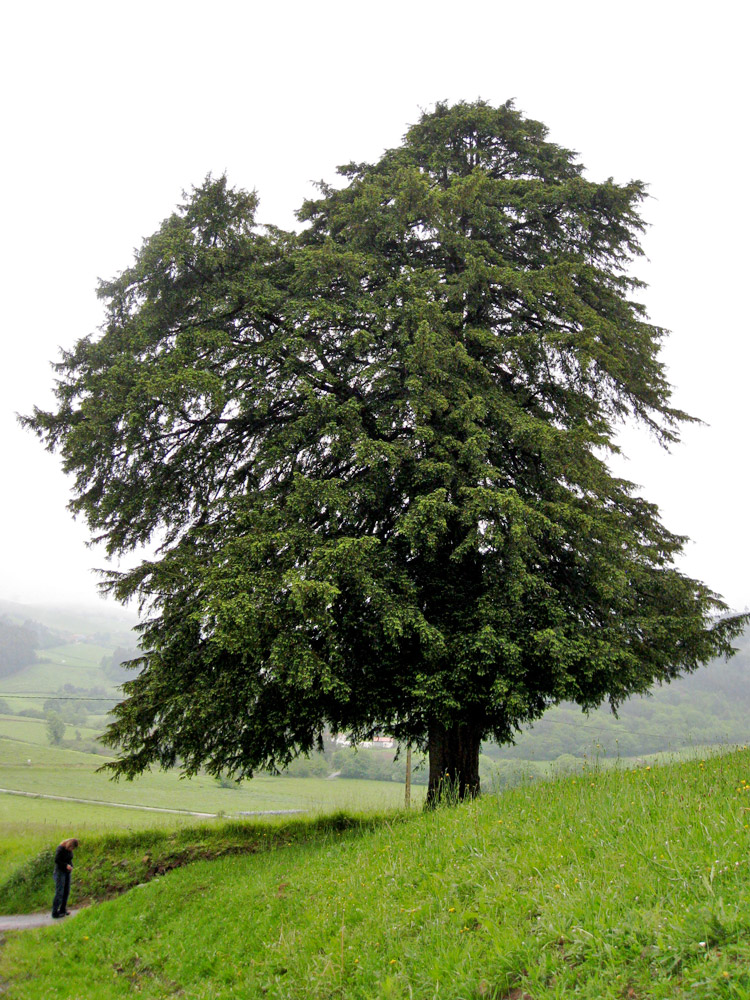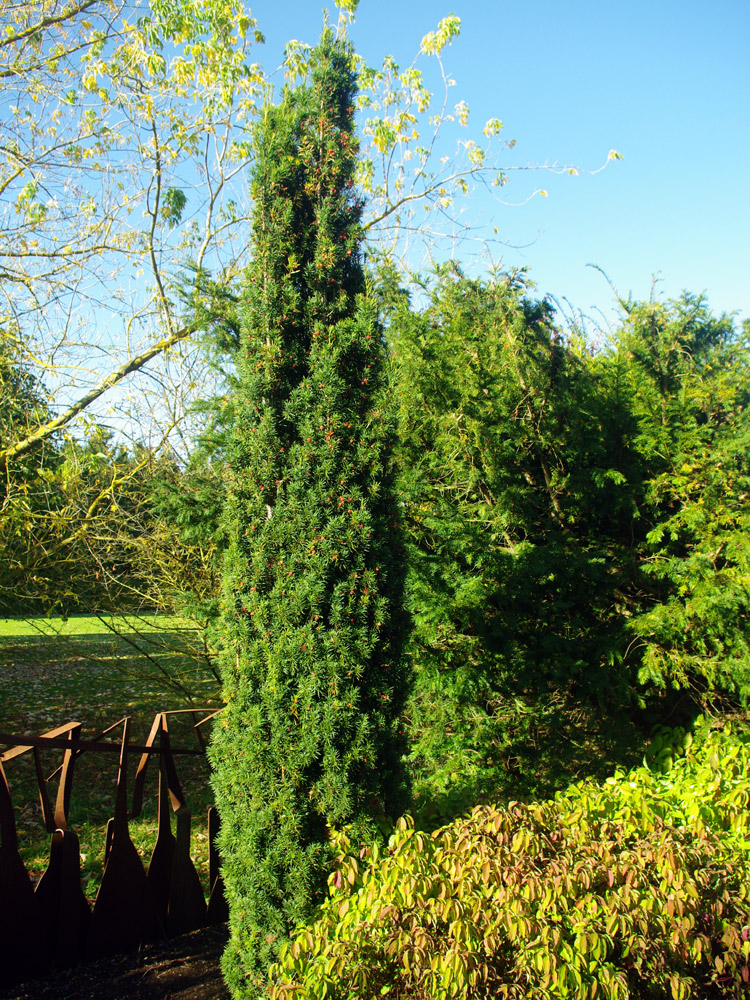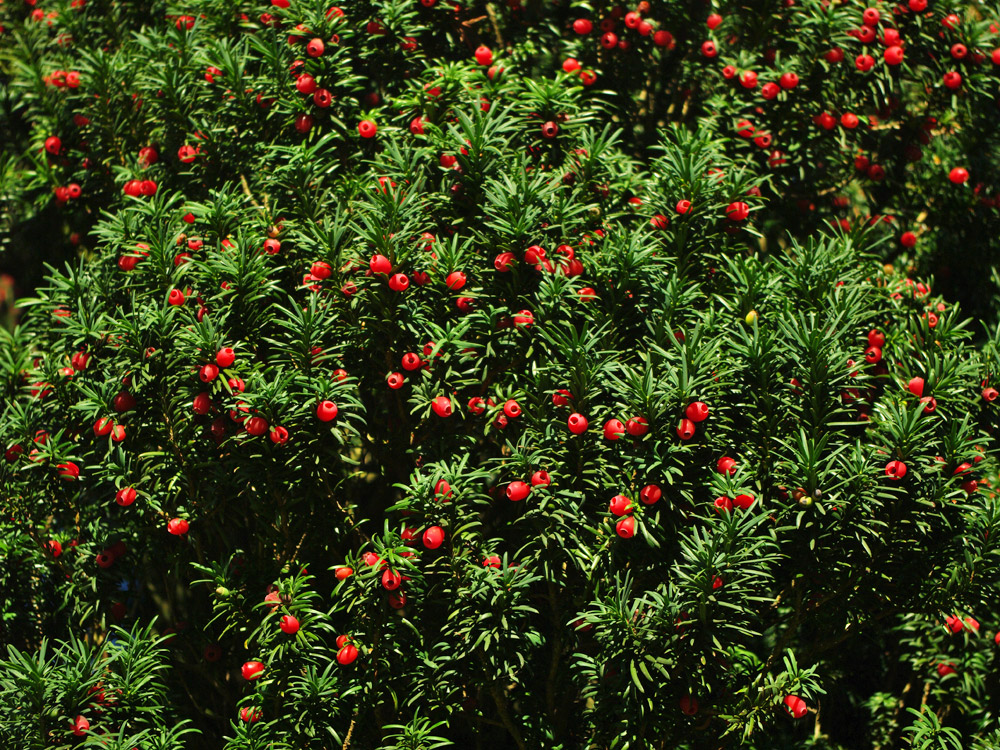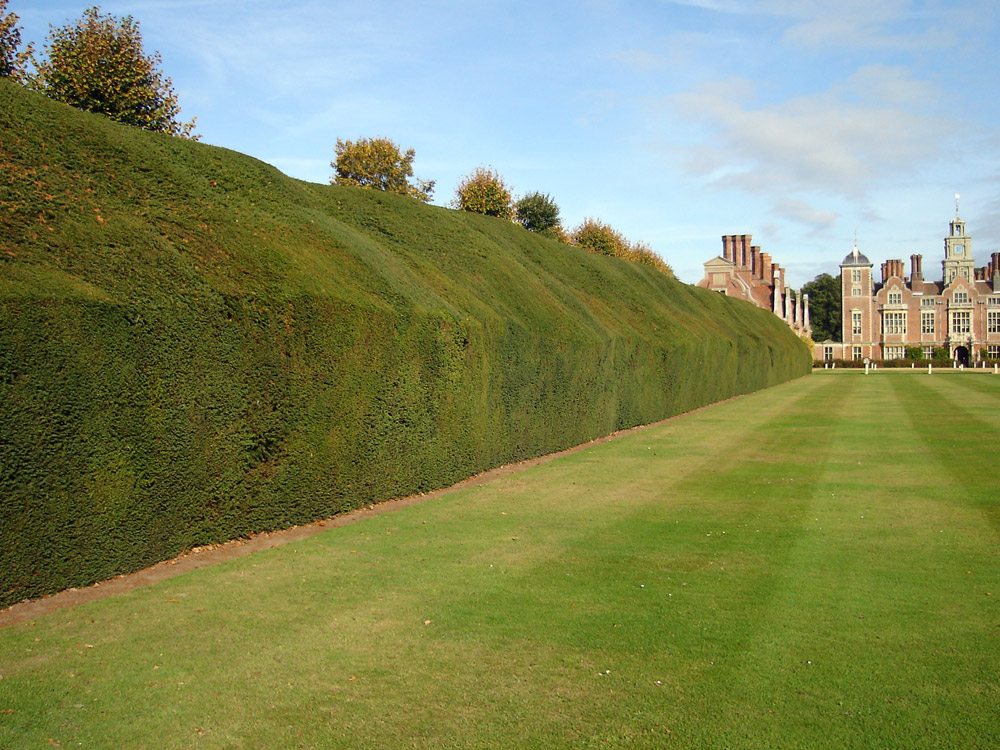Garden Plants - how and where to grow them
Shrubs &
Hedging
English Yew - Taxus baccata
Yew, along with box, is one of those plants that defines formal gardening. The trees are stately and with a certain unflustered dignity, when other plants are being blown all over the place or changing leaf colour, the yews disport themselves with statesman like decorum.
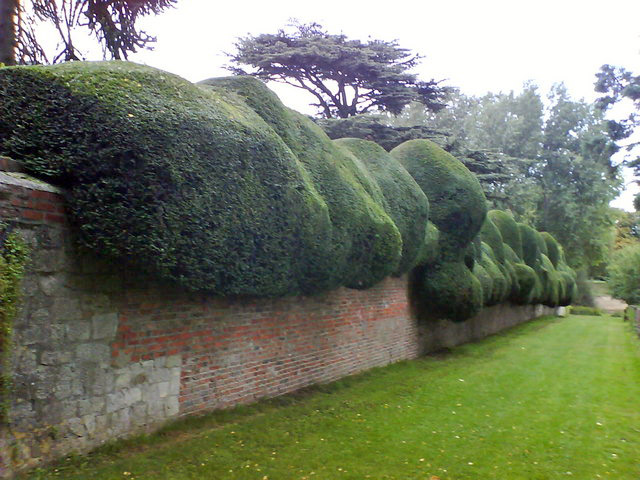 Yew have small needle-like, dark green leaves on horizontal
branches and fleshy, cup-shaped, bright-red autumn fruits on
female plants. The dark green foliage of this slow-growing,
evergreen conifer provides an excellent background for shrub
and herbaceous borders. Broadly conical in shape, it's tolerant
to dry shade, chalky and acid soils and urban pollution.
Yew have small needle-like, dark green leaves on horizontal
branches and fleshy, cup-shaped, bright-red autumn fruits on
female plants. The dark green foliage of this slow-growing,
evergreen conifer provides an excellent background for shrub
and herbaceous borders. Broadly conical in shape, it's tolerant
to dry shade, chalky and acid soils and urban pollution.
There are many named varieties of yew that make excellent architectural or specimen plants in the garden, several types are available with golden yellow leaves or patches of yellow against the green.
Yews can live to extremely old ages, The Oldest tree in Britain is the Fortingall Yew in Scotland estimated at over 4,000 years old while the oldest tree in Wales is the Llangerny Yew which is between 3,500 and 4,000 years old
- Height and spread: to 10m+ x 8m+ (30ft x 25ft) if left to their own devices over a period of decades, readily kept in check by trimming, particularly as they are slow growing.
- Position: full sun or partial shade
- Soil: any fertile, well-drained soil
- Rate of growth: slow-growing
- Other features: male cones in spring; female plants produce fleshy, cup-shaped, bright red autumn fruits; all parts of the plant are highly toxic if ingested. The ground under yews is notoriously unavailable to grow other plants - like gardening at night, it depends on the shape of the tree however. Good for making long-bows. Unfortunately Yew - at least English Yew, was never used for making bows (they weren't even called 'longbows', that's a Victorian name, rather 'Great Bow' or 'War Bow'). English Yew is too full of knots, and they would break very quickly. Ash, or Spanish Yew was preferred to make bows. Thanks to Peter Keen - Member of the Medieval Siege Society and Archer.
- Hardiness: fully hardy
- Garden care: Trim or renovate in summer or early autumn.
- Uses - Specimen / Hedging / Architectural
- Planting distance when used for hedging: 60cm, 24"
- Clipped height:1.2-4m, 4-12ft
- Number of times to clip per season and when: 2, spring and early autumn
- Pruning: Spring preferably, or early autumn. Renovate in mid-spring. Cut back to 15cm, 6" further than ultimate desired width or height, for large plants carry this out in stages, one side one year, then the other side the next.
- Responds to renovation?: Rather unusually for conifers, yews respond to renovation.
Questions about English yew, Taxus baccata
Q. I have a yew tree/hedge, it has grown into a tree of about 20ft high, the base has formed a beautifully thick hedge. This is however taking over the drive even though I trim it twice a year. I am frightened to cut deep back into the brown wood to clear it off of the drive and to encourage the hedge again, I would have to cut back about 18inches to 2 ft to do this. Can I do it and expect the hedge to regrow? If so how long will it take to regrow?
A. Yew is one of the few conifers that will respond well to hard cutting back by growing again from brown wood. How long to regrow? By next summer I'd expect the brown to be softened by a covering of green shoots again, if not a complete cover.
Q. I have an established hedge of English yew... on a few there is some dieback. It seems to affect the entire branch from the ground. my nursery said if I cut back the damaged/dead wood it would in time fill in, it has been three years and they still do not show any new growth anywhere near the hole I created. Should I have cut back the stem all the way to the ground? As it was I cut back only the branches coming from the main stem that were affected but now I seem to be slowly loosing other branches off that same stem. Any insight would be appreciated.
A. Yews usually respond well
if slowly (being slow growing) to such cutting back into brown
wood as long as the plant is healthy. It sounds sadly
that yours is not and that whatever it was that caused the branches
to die in the first place is still there causing damage. Yews
are susceptible to foot-rot caused by fungus and are particularly
vulnerable after wet winters, they don't like their roots
sitting in the wet when it's cold.
You could continue
to cut the dead branches off, but it sounds like your Yew has
a slow and probably terminal illness. If I were you I'd
probably try drenching the soil around the affected plants with
a proprietary fungicide, but it doesn't sound too hopeful
I'm afraid.
Q. I have a young Taxus baccata to plant as a specimen in inhospitable soil: gravel, rubble and clay. I shall excavate a hole for planting, and shall fill it with loam, bonemeal, manure, maintaining good drainage. Suppose the hole is diameter 1.5 metres, how deep should it be? Top dressing once planted is no problem.
A. That's a very generous planting hole! If the soil really is so awful, you don't want to artificially make it too easy for your tree as it will be a little too shocked later on.
I'd make the planting hole no more than 1m across and
30-50cm deep. Don't have any more than 50% of the material
in this hole as introduced goodies. Mix it well with the native
soil and top dress. I'd leave off the bonemeal for a few
years too as you can over-feed young trees easily. Clay soil
tends to be high in nutrients anyhow. The difficulty sounds
like soil texture and humous content. A mature Taxus will have
long strong roots, you need to harden it up for a tough soil,
don't lull it into a false sense of security.
Q. A friend of mine has extensive gardens which contain a large number of yew trees and bushes . Whilst most are very healthy some have died or are in the process of dying. Can you please give possible causes and remedies ?
A. It's always difficult to give a reply to this kind of question without seeing the plants or symptoms. Yew are usually very resilient to most pests and diseases, but the one thing that does get them is a type of phytophthora or foot rot. If it is this, then it will be caused by too much winter wet, the damage won't really show in the winter, but in the following spring and summer when the plants start into growth again (or not). There have been warnings that the loss of Yews could be a consequence of our warming climate due to excessive wet at the roots over the winter, maybe what you're seeing is a symptom of this.
What to do about it? Improve drainage where possible and practicable, I'd guess though that if you have a large number of large trees and bushes this would be more of a civil engineering task.
Photo credits: (numbering left to right top to bottom) 1-Matthew Hatton - Creative Commons Attribution 2.0 license. / 2-Sitomon - Creative Commons Attribution 2.0 license. / 3-Paul Ward - angliangardener.co.uk / 4-Paul Ward - angliangardener.co.uk / 5-Paul Ward - angliangardener.co.uk / 6-Paul Ward - angliangardener.co.uk / 7-The Yew Hedge Blickling - Public domain
Copyright 2000 - present. All Rights Reserved | Privacy Policy Statement

